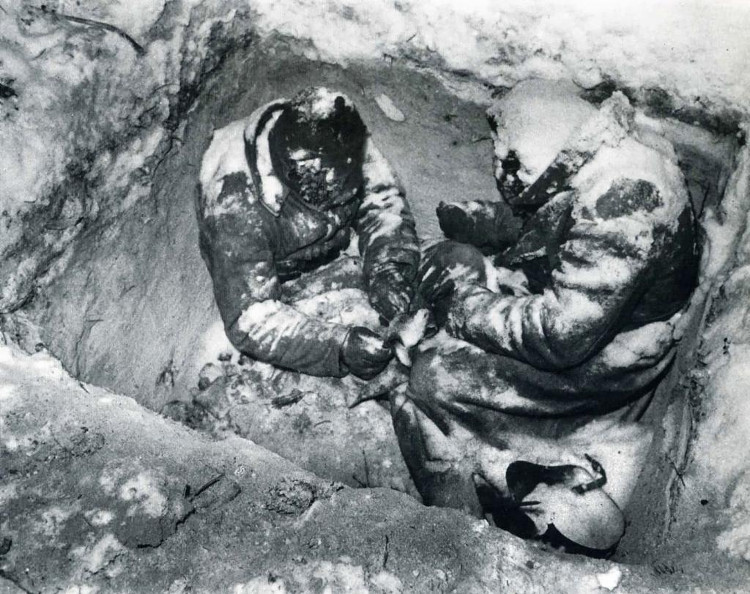The paradox of self-liberating victims when they are about to freeze to death
Many victims of hypothermia perform strange behaviors such as "burrowing" and undressing themselves before completely losing consciousness.
Hypothermia is a condition that occurs when the body's central temperature drops below 35 degrees C. When hypothermia, the victim begins to shiver, most will experience movement problems such as stumbling or slowing. . People with hypothermia may also be confused, lose consciousness, and have a tongue-twister when talking or acting like alcohol.

Severe hypothermia can result in death.(Photo: Rare Historical Photos).
If hypothermia becomes severe, respiratory and heart rate can be reduced to dangerous levels. Victims may lose consciousness, even die. However, before being completely unconscious, the victim will perform some strange behavior such as "burrowing" and undressing himself , according to Live Science.
In the winter of 1847, the Donner Party, a group of pioneers emigrating to California, was trapped in the Sierra Nevada Mountains amidst a snowstorm. Hungry and thirsty, they tied the blankets together to create a tent to keep warm and prevent snow. However, that was not enough to save Patrick Dolan, a member of the team.
Patrick Dolan was quite weak a few days ago. On the first night without fire, he started delirium. While whispering meaninglessly, Dolan took off his torn clothes and ran out of the tent, rushing into the snow.
The rest of the party did not have enough strength to run after him. A few hours later, Dolan circled around the tent. Some people had to go out and drag him, now screaming and almost naked, into the tent. Dolan died that night.


The immigrant Donner Party is stuck in a snowstorm.(Photo: NPR).
A study of the cases of frostbite in the period of 1978 - 1994 showed that the number of outdoor and indoor deaths is nearly equal. Twenty-five percent of victims have only a few clothes left or are wearing nothing at all. They often take off clothes from the front, that is, take off pants and shoes before going to the shirt.
Hot hibernating animals often dig a small, enclosed cave for shelter during the winter. Narrow caves help animal bodies limit heat loss. In the last moments before frostbite, humans also performed a similar behavior that researchers call "burrowing at the end".
In 1995, a group of German researchers described victims of frostbite in a posture showing the last human defense mechanism, such as lying under a bed, behind a closet, in a shelf, according to an international magazine. Legal Medicine.
Scientists have not studied extensively and understood the end-of-the-cave behavior. However, the German team believes that this is an independent process of the brain stem, activated in the late stages of hypothermia, leading to primitive behavior similar to burrowing to protect the body, similarly. like hibernating animals.
Another behavior is more bizarre and confusing than burrowing is the "self-deprecating paradox". Accordingly, many victims of hypothermia have escaped most or all of their body clothes, causing body temperature to decline.
When heating the body of a person with hypothermia with another person's body, first-aid professionals often advise both the victim and the heating person to wear naked or wear very little. This makes it easier for the warmth to move from the warmth to the victim. However, scientists believe this advice has nothing to do with the paradox of undressing itself.

Many victims take their clothes off when they are freezing, causing the body temperature to drop.(Photo: The Old Reader).
To prevent warmth from escaping from the limb, the body will contract itself, ie the shrinking reflex of blood vessels. But gradually, the muscles needed during the vasoconstriction become exhausted and cannot function properly, causing warm blood to flow out of the limbs. This triggered a sudden heat that caused the victim, who was now unconscious, to feel hot and undress himself, the researchers said.
Self-undressing paradoxes often occur right before the last burrowing behavior. The German team, when investigating victims of hypothermia, notes that the final posture of the body can only be formed when the victim crawls, crawls, causes scratches on the elbow or knee. This action occurs after undressing, because on the skin there are scratches but the corresponding position on the clothes is not harmful.
Due to the last burrowing behavior and the self-undoing paradox, many frostbitten victims have been misunderstood as being attacked by others. Some police investigators often mistakenly believe a nude person died as a victim of sexual assault and murder. The detection of the body inside a small enclosed space like under the furniture is similar to the act of hiding it.
- Crazy with paradoxes 'quiz you prove'
- The truth behind three 1,000-year paradoxes no one could solve
- Strange story about murderer
- This is the answer to Zeno's famous paradox, about the Achilles hero racing against the turtle
- Obesity paradox: Fatty people have the lowest risk of death
- 'Solicitation' for reporters to take photos without saving the victims
- 4 apocalyptic scenarios of the universe
- Why should not move the accident victims?
- Overwhelmed by the phenomenon of
- Why aliens have not come?
- Black hole and Hawking paradox
- Sharks prefer to attack men more than women
 'Fine laughs' - Scary and painful torture in ancient times
'Fine laughs' - Scary and painful torture in ancient times The sequence of numbers 142857 of the Egyptian pyramids is known as the strangest number in the world - Why?
The sequence of numbers 142857 of the Egyptian pyramids is known as the strangest number in the world - Why? Miracle behind the world's largest stone Buddha statue
Miracle behind the world's largest stone Buddha statue What is alum?
What is alum?